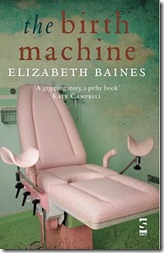
Welcome, my son, welcome to the machine.
What did you dream?
It's alright, we told you what to dream.
Pink Floyd, ‘Welcome to the Machine’
How do you tell a story? Start at the beginning and move steadily towards the end, silly – begin at ‘Once upon a time’ and keep going until you reach ‘Happily ever after’ – everyone knows that. And that’s the way stories have been told since time immemorial. Up until recently. Since the advent of cinema the public has become more and more adept at following ever-increasingly complex storylines beginning in media res, flashing forward in time, jumping back, plopping into subplots and skipping from third person narratives to first and back again. Fairy stories these are not. And The Birth Machine by Elizabeth Baines is certainly not. But it begins like one:
Once upon a time there lived a king and queen who had no children; and this they lamented very much. But one day as the queen was walking by the side of the river, a little fish lifted its head out of the water and said, "Your wish shall be fulfilled, and you shall soon have a daughter."
You might recognise it. It’s from Edgar Taylor’s 1823 translation of the Grimms’ fable ‘Dornroeschen’ which he rendered as ‘Rose-Bud’ – we know it better these days as ‘Sleeping Beauty’. You can read it in full here (jump down to #177). Personally I don’t remember the fish in fact Disney’s version is so ingrained on my head I found I remembered very little of this version.
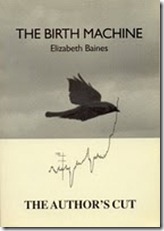 Fairy tales of course frequently exist in a variety of forms and it’s usually the one we read (or see) first that becomes the definitive version in our heads. Even though there have been in total a whopping-great seven different versions of Blade Runner the one I remember was the one I saw in the cinema in 1982, the International Cut, although I have since seen the other two must-see versions, the 1992 Director’s Cut and the 2007 Final Cut. It’s rare for books unless they’re translations to have more than one edition but The Birth Machine has. The book was first published in 1983 by The Women’s Press. A revised version was self-published in 1996 retitled The Birth Machine - The Author's Cut and now a further revised, and – hopefully – final version, has now been published by Salt Publishing. Unusual to say the least. You can read the whole history on her blog here.
Fairy tales of course frequently exist in a variety of forms and it’s usually the one we read (or see) first that becomes the definitive version in our heads. Even though there have been in total a whopping-great seven different versions of Blade Runner the one I remember was the one I saw in the cinema in 1982, the International Cut, although I have since seen the other two must-see versions, the 1992 Director’s Cut and the 2007 Final Cut. It’s rare for books unless they’re translations to have more than one edition but The Birth Machine has. The book was first published in 1983 by The Women’s Press. A revised version was self-published in 1996 retitled The Birth Machine - The Author's Cut and now a further revised, and – hopefully – final version, has now been published by Salt Publishing. Unusual to say the least. You can read the whole history on her blog here.
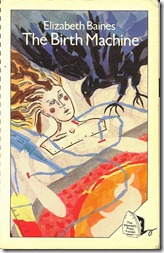 Just as directors don’t always have total control over what ends up on the cutting room floor authors don’t always have as much say as you might imagine when it comes to what their editors do with their blue pencils. To say that the edition published by The Women’s Press was butchered is probably going too far but changes were made. The most significant alteration was where the story starts. The editor decided that the book should begin with chapter four which opens with:
Just as directors don’t always have total control over what ends up on the cutting room floor authors don’t always have as much say as you might imagine when it comes to what their editors do with their blue pencils. To say that the edition published by The Women’s Press was butchered is probably going too far but changes were made. The most significant alteration was where the story starts. The editor decided that the book should begin with chapter four which opens with:
Earlier that morning she shivered in the hospital corridor. A new admission for induction of labour.
Considering the book is called The Birth Machine and in this latest edition there’s a gynaecological couch on the cover you might not think that such a bad decision, to cut to the chase. But is that where the story begins? This is how Disney’s version of Sleeping Beauty begins:
In a far away land long ago lived a King and his fair Queen. Many years had they longed for a child and finally their wish was granted. A daughter was born. They called her Aurora. Yes they named her after the dawn for she filled their lives with sunshine.
Aurora is the Roman goddess of the dawn by the way.
So no fish then. There was no fish in the original either. The Grimms added that bit in. An element of their writing style is how their tales invariably include magic and communication between animals and humans.
The most recent version of The Birth Machine opens with chapter one reinstated to its rightful position:
Ladies and Gentlemen: the age of the machine.
Ladies and Gentlemen, we are proud to welcome to Boston Professor McGurk, who has flown in from England to lecture today on the latest developments in the use of the machine.
So are we in some kind of auditorium or lecture hall? No, we’re actually inside the Professor’s head. His wife is pouring his cornflakes while he flicks through his diary; he is a man much in demand: “you’re lucky to catch him, sometimes he’s late, sometimes he’s gone already when you get there; often he regrets he can’t be there in any case.” The Professor is a man of science and he has complete faith in it. Science though is all about doubt and the effort to resolve it. He has forgotten that in his . . . I was going to write ‘self-assuredness’ but really the word I was looking for is ‘arrogance’.
We do get to meet the woman who earlier that day had been shivering in the hospital corridor, Mrs Harris, Zelda, the wife of Dr Harris, a colleague of the Professor’s as it happens. First impressions are important. Elizabeth Baines didn’t want our first impression of Zelda to be her standing in a hospital corridor, no; she wanted us to see her through the eyes of the Professor’s students, as Elizabeth says in her Author’s Note at the end of the book, “as an object in his virtuoso demonstration.” Without her, without some body to undergo processing, there is no way to see just how wonderful the machine is:
“Good morning, Mrs Harris. Mrs Harris is about to benefit from our modern technology. Aren’t we, Mrs Harris?” He says with a wink in Mrs Harris’s direction: “Mrs Harris is a rather special patient. How are we feeling, Mrs Harris?”
He turns back to the students: “Now to connect the patient up to the machine.”
You just want to slap him, don’t you?
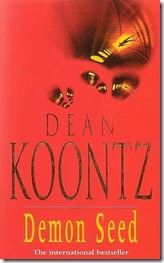 When I first heard of this book, a couple of years back in fact, I wondered if it might be a science fiction novel; the book Demon Seed came to mind, a book that, coincidentally, also exists in two versions. This isn’t the case but there is common ground. In both books machines are heavily relied upon to provide for the comfort and safety of humans. In reality ‘the machine’ that is going to look after Zelda and her unborn child is actually two machines but really Elizabeth is using the term ‘machine’ here in a much broader sense.
When I first heard of this book, a couple of years back in fact, I wondered if it might be a science fiction novel; the book Demon Seed came to mind, a book that, coincidentally, also exists in two versions. This isn’t the case but there is common ground. In both books machines are heavily relied upon to provide for the comfort and safety of humans. In reality ‘the machine’ that is going to look after Zelda and her unborn child is actually two machines but really Elizabeth is using the term ‘machine’ here in a much broader sense.
Although the book does not shy away from describing the birth of Zelda’s baby in great (although not gratuitous) detail, obstetrics is not the real issue here, simply a convenient context for examining bigger issues. She writes:
[M]y intention when I wrote The Birth Machine in 1982 was to tell a story exploring the hubris of much contemporary ‘scientific’ thinking. In particular, I was interested in the contemporary tendency to overlook, or even deny, the factor of uncertainty.
My daughter was born in 1980 and so this brought back many memories for me. I recall inquiring as to the functions of the various contraptions that crowded around the head of the bed, what the readouts indicated and what warning signs I should be on the lookout for. Also I remember how I was lightly dismissed by the staff when I advised them that the readings were drifting into the danger zone; a little knowledge is a dangerous thing.
This is not the first time I’ve read a book by Elizabeth Baines. A few months back I read her novel Too Many Magpies, a book that also deals with the divide between science and magic, and you can read my review of it here. I had a difficult time getting into it and I might have had a similar problem with this earlier novel if I hadn’t anticipated a similar approach to her subject matter. There are several intertwined storylines going on here and it takes a wee while to connect them:
1. The induction of her child from Zelda’s perspective
a. While drug free
b. While medicated
2. The birth from the point of view of various members of staff
3. The events leading up to her pregnancy and admission
4. A series of events from Zelda’s childhood
5. The experiences of two medical students
6. The experience of her husband’s staff
In presenting the story in the way she has what Elizabeth has been trying to do is break her readers in gently – ‘wean’ is the word she uses – so that we start off from a safe ‘objective’ distance before being asked to submerge ourselves in Zelda’s worlds of childhood and impending motherhood. Starting with a man also seemed to her like a good way to rope in potential male readers. And I agree.
![clip_image002[4] clip_image002[4]](http://lh4.ggpht.com/_kmVGrSP_9gU/TNGU29QrR4I/AAAAAAAADsw/_gF5pKdmiVs/clip_image002%5B4%5D_thumb%5B2%5D.jpg?imgmax=800) This is where I feel that Salt’s cover design lets the book down (even though it was designed by a man) because as a male I can’t imagine sitting on a bus riding along the side of the Clyde with a bunch of working men reading a book with a dirty great pink gynaecological couch on the front cover. Now if they’d used H R Giger’s Birth Machine on the cover that might have been very different (see my quick suggested cover aside) notwithstanding how much they would have been charged for permission to use the image in the first place. My wife was also “creeped out” by Salt’s cover. She said “It makes me shudder.” I never read my copy of The Yellow Wallpaper on the bus for exactly the same reason – the cover. I much prefer the cover to The Author’s Cut and I’m rather sorry now I didn’t stick it on my Amazon wish list when I first discovered it.
This is where I feel that Salt’s cover design lets the book down (even though it was designed by a man) because as a male I can’t imagine sitting on a bus riding along the side of the Clyde with a bunch of working men reading a book with a dirty great pink gynaecological couch on the front cover. Now if they’d used H R Giger’s Birth Machine on the cover that might have been very different (see my quick suggested cover aside) notwithstanding how much they would have been charged for permission to use the image in the first place. My wife was also “creeped out” by Salt’s cover. She said “It makes me shudder.” I never read my copy of The Yellow Wallpaper on the bus for exactly the same reason – the cover. I much prefer the cover to The Author’s Cut and I’m rather sorry now I didn’t stick it on my Amazon wish list when I first discovered it.
The Yellow Wallpaper is, of course, regarded as an important early work of American feminist literature and it would be easy to read The Birth Machine purely as a feminist novel. It is but that’s not all it is. This is how Elizabeth herself describes the book:
The Birth Machine concerns a woman about to give birth who finds herself silenced (and her subjective experience discounted) by not just the system and apparatus of the medical profession, but above all by its language and logic – which indeed to some extent she has internalised. For me above all it's a novel about language, and scientific logic and the competing power of dreams and myth and intuition. The protagonist Zelda also has a buried secret, and the novel is also about the silencing power of repression.
I asked Elizabeth if she saw any connection between the two books:
Gosh, The Yellow Wallpaper. Well, I know when I read that I was very impressed and affected – I guess I must have been influenced: wouldn't be surprising, though no one else has seen the connection, and I hadn't thought of it myself. I guess they're both about women trapped – psychologically as much as anything.
If you don’t know The Yellow Wallpaper this is what it’s about according to Wikipedia:
Told in the first-person perspective as a series of journal entries, the story details the unreliable narrator's descent into madness. The protagonist's husband, John, believes that it is in the narrator's best interest to go on a rest cure, since he only credits what is observable and scientific. He serves as his wife's physician, treating her like a powerless patient. The story hints that part of the woman's problem is that she recently gave birth to a child, insinuating she may be suffering from what would now be called postpartum psychosis.
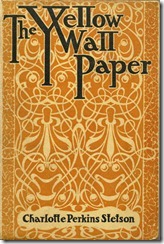 So, in both books, males are in charge. In Zelda’s case it’s a male professor and a male husband who oppress her. There’s no doubt that each of them of them believes that they’re doing the best thing for her and especially the baby but trying to get a simple answer to a simple question proves impossible whether Zelda is talking to a male or a female and I found the experience exactly like that when my first wife was in labour: no one would give me a straight answer to a straight question.
So, in both books, males are in charge. In Zelda’s case it’s a male professor and a male husband who oppress her. There’s no doubt that each of them of them believes that they’re doing the best thing for her and especially the baby but trying to get a simple answer to a simple question proves impossible whether Zelda is talking to a male or a female and I found the experience exactly like that when my first wife was in labour: no one would give me a straight answer to a straight question.
The question Zelda wants answered is a simple enough one. Before being admitted she asks her husband to ask the Professor and when he gets home he hasn’t got his coat off before she wants to know:
“Did you speak to the Professor?”
“Yes.”
“What did he say?”
“It’s OK. There’s nothing wrong. It’s just a precaution.”
“Roland! Precaution? Against what?”
He lifted two palms. “I don’t know . . . anything. Any of the complications of late pregnancy. They’re just making absolutely sure that everything goes properly.
Control is a big issue in this novel. Women have been having babies for thousands of years. Their bodies take control and, complications notwithstanding, several hours later out pops a wee baby. My mother had no great love of doctors and her experiences of childbirth were not pleasant ones. She probably would have died were it not for the intervention of modern medicine but she was no great advocate for their cause and many times she advocated natural childbirth. She’d tell me about African women who had babies out in the fields, who’d just squat down, have their babies and then get on with sowing or whatever it was they’d been doing ten minutes earlier. There’s something luxurious though about not having to be responsible. People pay through the nose for others to take care of them but the difference there is that not being responsible doesn’t rob them of their power. Zelda is systematically robbed of her power. She is treated, and spoken to, like a child:
The new Sister on duty pops her head round. Mrs Harris has her eyes closed. Is she asleep? Is she dreaming?
She opens them and looks straight back.
“That’s right, Mrs Harris, have a sleep, you’ll need it, that’s a good girl.”
Good girl, Zelda.
In The Yellow Wallpaper the woman’s husband also uses this kind of demeaning language: when his wife asks about leaving the room in which she is resting he calls her “a blessed little goose” and later when she first notices a faint figure behind the pattern and calls his attention to it he calls her his “little girl.” It is this kind of treatment that causes Zelda to lapse into her childhood reminiscences.
What is interesting about the first memory that Zelda has is that it also incorporates a controlling male, her father. In the dark she creeps down to the kitchen where she finds her father making something on the hotplate:
He said without turning: “What in hell are you doing here?”
She said, “I’m hungry.”
He snorted. The thing on the hotplate whispered.
“What are you making?”
“Toast.”
She came and peered. “That’s not toast.”
“Call it what you like. I call it toast.”
The slice glistened on the stove, deep yellow, emitting tiny bubbles at its lower edges. She saw he’d done something new: buttered the bread first, before cooking. He did another for her, turned the loaf on its end and sawed across flatwise.
So he’s not uncaring. None of the men in the book are uncaring per se. They are all in charge though. Her father could just as easily have told her to go back to bed and he does exactly that when she starts to overstay her welcome. The same happens in the hospital. She gets hungry but is completely at the mercy of the hospital staff. They decide what she can have and when, even something as simple as a cup of tea. The machines are monitoring her so their contact is minimal. And even there it’s not her body that’s in control of her own contractions; she practices the natural breathing techniques she’s been taught but this only provides her with the illusion of control; there is nothing natural here. She’s praised for doing these but only because, because Zelda believes these are doing her good, they keep her quiet, calm. She gets a “good girl” for that. When she cries out in pain it’s another thing completely:
The nurse says, “Now come on. You were doing so well. Remember your exercises, you haven’t forgotten them, have you?” She shoots a meaningful glance. “And think about your baby. You haven’t forgotten him, have you? He’s best if you’re calm. That’s a good girl.
Interesting that the child is used to threaten her with. Much the same happens in The Yellow Wallpaper when John says, “I beg of you, for my sake and for our child’s sake, as well as for your own…” [Italics mine]
Zelda is a natural woman. By that I suppose I mean a child of nature but that sounds a bit pretentious. She has grown up at a time when children were used to roaming the countryside without the same fear of molestation that exists today. That was my childhood. Childbirth in the old days was very much a concern of women. The men toddled off hunting and left their wives in the care of “what Adrienne Rich has called the stereotype of ‘the filthy peasant crone’”[1] a character that wouldn’t look out of place in any of Grimm’s fairy tales. These roles are played by Zelda and her friends, Annie and Hilary – too old at thirteen? – who, along with Zelda, concoct magic potions in their den and attend to their plastic doll-babies. While the now-adult Zelda is drugged she hallucinates seeing Hilary there in the delivery room and imagines Roland saying, “What’s she doing here? Look, she isn’t scrubbed up, she isn’t aseptic, she’s a hazard, send her home.” In the den though the girls have all the power. Hilary drags along her little brother on occasion but all he seems to do is whinge. It is the boy, however, that reminds the girls about “the thirteenth fairy’s promise.” The childhood tale appears repeatedly throughout the book; the fish takes on a more pronounced role, that of guide.
After Zelda’s child is born she is lying in bed still sedated and memories of the recent and distant pass all are mixed up in her head:
Things gone wrong. Patterns inverted.
A simple start, a simple wish. A fish jumps, sperm-shape, comma in the flow of things, a simple movement, automatic, primordial. The fish blows a clean bubble. “Oh, Lord and Lady, thy wish shall be granted.” The pastel lady starts. Her husband in the distance is gathering blue nettles. The bubble bursts. The prophecy scatters, to reassemble in a different pattern.
[…]
It was wrong. An inversion. The princess mustn’t awake. Said the thirteenth fairy: the princess must die; and then the twelfth fairy spoke: I will lessen the spell; the princess will merely sleep. But only when it’s a prince who comes breaking through the tangle may there be waking, and the forest put out flowers like blood.
Who was her prince? The boy hiding behind the trees, who only wanted to play, who they left alone? Was he Roland, her husband, Roland the professional, the straight man, the stiff man, the man who never once had brought her to orgasm? Or is the prince her son whose arrival causes Zelda to wake up in the truest sense?
The Yellow Wallpaper ends with an escape:
“I’ve got out at last,” said I, “in spite of you and Jane. And I’ve pulled off most of the paper, so you can’t put me back!”
and so does The Birth Machine in fact Zelda doesn’t wait for her prince:
She can break the seal. She can make her own inversion.
I enjoyed this book very much. It’s the best thing I’ve read by her (I’ve also read her collection of short stories) and I’m happy to recommend it, to men (and not simply fathers) as well as women (and not simply feminists). There is a danger to reading this book simply as an historical document, a record of how women used to be treated during childbirth although it is that. At the time of the release of the first edition, Katy Campbell, reviewing the book for City Limits, declared the book “especially recommended for anyone involved in the Obstetrics industry.” The medical profession has moved on somewhat since then but have attitudes towards women? And what about women’s attitudes towards themselves? I’m as much of a feminist as the next man but what I have noted is that some of the problems women face are not because they are made to do things but they allow things to be done to them. The main male characters in this book are not bad men; are not out to hurt her. (There is one very bad man in the flashbacks who is out to hurt someone.) It’s Zelda that lies back – literally – and takes it. For the most part. We do witness her turn and that is why the whole fairy tale backdrop works so well; modern life is not a fairy tales and people don’t live happily ever after.
You can read a sample from the book here.
***
 Elizabeth Baines' grandmother claimed to be a descendent of the family of the Welsh bard Will Hopkin. The fact that the truth of this is unknown was not enough to deter Elizabeth from deciding at an early age to be a writer in his footsteps. Born in Bridgend, South Wales, to a Welsh mother and an Irish father, she studied English at Bangor, and for several years was a teacher of English in schools in Scotland and England. She is the prizewinning author of prose fiction and plays, with an established career as an acclaimed radio dramatist. With Ailsa Cox, she founded and edited the acclaimed short-story magazine Metropolitan (1992-97). Her collection of short stories, Balancing on the Edge of the World, was published by Salt in 2007 and pronounced 'a stunning debut collection' (The Short Review). In 2004 she took up occasional acting by performing one of her own stage monologues for the 24:7 Theatre Festival. She lives in Manchester. She writes the well-regarded Fictionbitch blog and her own author blog.
Elizabeth Baines' grandmother claimed to be a descendent of the family of the Welsh bard Will Hopkin. The fact that the truth of this is unknown was not enough to deter Elizabeth from deciding at an early age to be a writer in his footsteps. Born in Bridgend, South Wales, to a Welsh mother and an Irish father, she studied English at Bangor, and for several years was a teacher of English in schools in Scotland and England. She is the prizewinning author of prose fiction and plays, with an established career as an acclaimed radio dramatist. With Ailsa Cox, she founded and edited the acclaimed short-story magazine Metropolitan (1992-97). Her collection of short stories, Balancing on the Edge of the World, was published by Salt in 2007 and pronounced 'a stunning debut collection' (The Short Review). In 2004 she took up occasional acting by performing one of her own stage monologues for the 24:7 Theatre Festival. She lives in Manchester. She writes the well-regarded Fictionbitch blog and her own author blog.
FURTHER READING
Analysis of Grimm Brother's Briar Rose/Sleeping Beauty
Analysis of Disney's version of Sleeping Beauty
The Author’s Note from the book.
REFERENCES
[1] Tess Cosslett, Women Writing Childbirth: Modern Discourses of Motherhood, p.31



8 comments:
I know a number of midwives.They tell me birth in hospitals is as bad as it's always been for women.Something about technology and doctors taking over and disempowering.Not much has changed.
You probably know the Grimm brothers simply collected tales from many women, some they were related to, some were neighbours and others in different parts of the country.The tales are old and part of their heritage but they merely wrote them up.
Nice to see another Australian has found their way to my blog, Von. I’m pretty sure you’re my only goose breeder though. I know what you mean about the Grimms but they did elaborate on the tales which is all I was saying here. As regards hospitals and the attitudes of doctors I don’t think the attitudes expressed in this book are unique to obstetricians. My wife visits a rheumatologist who also needs to be taken by the lapels before he’ll listen to her. There’s this reluctance to part with information too as if it will hurt you to know what’s happening or what might be wrong with you. Very frustrating.
Modern medicine has made childbirth so machine-like. Lying on her back, totally out of control, her feet in the air, propped into an ergonomically horrid position, a woman is asked to push against gravity and deliver offspring.
Childbirth is a combination of science and magic.
Perhaps there is something appropriately symbolic for children born into our current society -
...so many constructs and contraptions they hope will have mercy on them...
I have to agree with you there, Kass. There really was something magical about watching my daughter being born. It doesn’t matter how much you understand the science actually witnessing one living creature being drawn from the body of another is something else, especially when you contributed to it being there. The hospital staff were actually quite nice on the whole (and predominately Irish for some reason) but part way through I found myself in tears in the Gents swearing I’d never put anyone though this again and it wasn’t even a bad labour – about twelve hours if memory serves me right – Christ knows what I would have been like if things had gone badly. I can understand not explaining to me what was going on but I hated it. Part of me would rather have sat in the waiting room like the fathers had to do in the old days; there's a lot to be said for ignorance.
I think you have the germ of a poem in that last line by the way.
I'll have to put this on my list of books to track down. I was willing, with my last baby, to have a "freebirth" (unattended birth at home) just to avoid the hospital "machine." I think birth is a natural, normal process, and in our society today, it has become a "disease" - something that needs to be hospitalized, treated by doctors, dosed with drugs, even be subject to surgery. Midwives are one answer, but one must be careful with midwives, as some midwives are just as "hospitalized" as the doctors are. I feel very strongly that pregnant women today are being lied to about their options and their pregnancy. Thanks for reviewing this book.
There are different kinds of lies, Koala Bear Writer, and the one in this book is the one that I see the most of – lies of omission. All the woman in this book wants is an answer to a simple question which she gets but only after the fact, when it’s too late to affect her decision. I see doctors do this all the time, only share as much as they see fit to. There are arguments for and against this approach – yes, why worry a patient needlessly – but whose information is it at the end of the day? Thanks for your thoughts – nice to see a new name appearing in the comments.
Another terrific review, Jim. I enjoy the comparison between Elizabeth Baines's book and the Yellow Wall Paper.
I only came across the Yellow Wall Paper about six years ago and it sent me through the roof.
I found it so thoroughly fantastic. I think I shall enjoy Elizabeth Baines's book, too. It puts me in mind of my own labours.
I gave birth to my first daughter in 1982 and in those days beyond the horrors of the labour, afterward while we stayed in hospital for the mandatory seven days, we were required to weigh our babies before and after each feed. We were told not to change their nappies in the process. The medicos wanted to measure exact intake and output, exact increases in weight. We needed then to record the exact amount of change in the baby's weight on the scales. Only after the baby had regained the inevitable initial loss of weight post birth could we take the baby home.
Draconian methods like this stay with me. I still feel persecuted at the thought - the patronising attitudes and the machines.
I hate to say it, but once you are in hospital whether for birth or death, the same depersonalising process seems to go on, as it did recently for my broken leg.
Hospitals are horrible places in which to stay, however necessary they may be.
Thanks, Jim.
I get Feminism, Lis, I really do. I’m not sure I’d call myself one but I’m definitely pro-women and I recognise they’ve had a hard time of it over the years. I expect it was growing up with a domineering father and watching how all the fight got kicked (metaphorically) out of my mother over the years, That doesn’t mean my dad was a bad provider – my mother never wanted for anything in practical terms – but things weren’t important to her. And that’s what got me about The Yellow Wallpaper when I first read it. You couldn’t call the husband ‘bad’ and I’m sure if he’d been told he was oppressing his wife he’s have been offended. It’s the old bird-in-a-gilded-cage-scenario.
My daughter was born in 1980. I’m actually not sure how long my wife was in hospital. I don’t think it was as long as a week but she was transferred from the maternity unit to a hospital closer to where we lived for a few days at least. I’ve written a bit above about my memories of that time which is why I no doubt connected with The Birth Machine but you’re right, it’s not just obstetrics, it’s all forms of health care that are geared towards processing patients as opposed to treating individuals. In my forthcoming article about R D Laing’s time in Glasgow’s Gartnaval I wrote this: “Laing noticed that none of the doctors actually talked with the patients – they treated them as ailing organisms as opposed to poorly people…” He’s talking about mentally ill people, schizophrenics, and the fact is the doctors were caring for the patients as best they knew how but somewhere along the line they’d forgotten they were dealing with people. For all Laing’s failings if the only thing he did was get his colleagues to sit up and realise what they were doing then the boy done good as far as I’m concerned.
Post a Comment